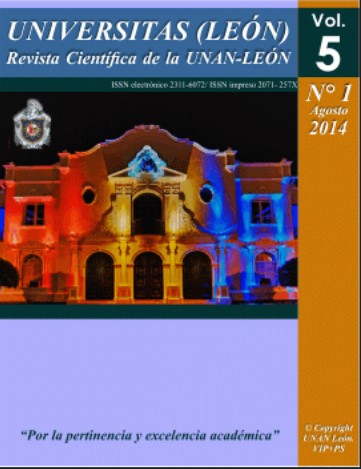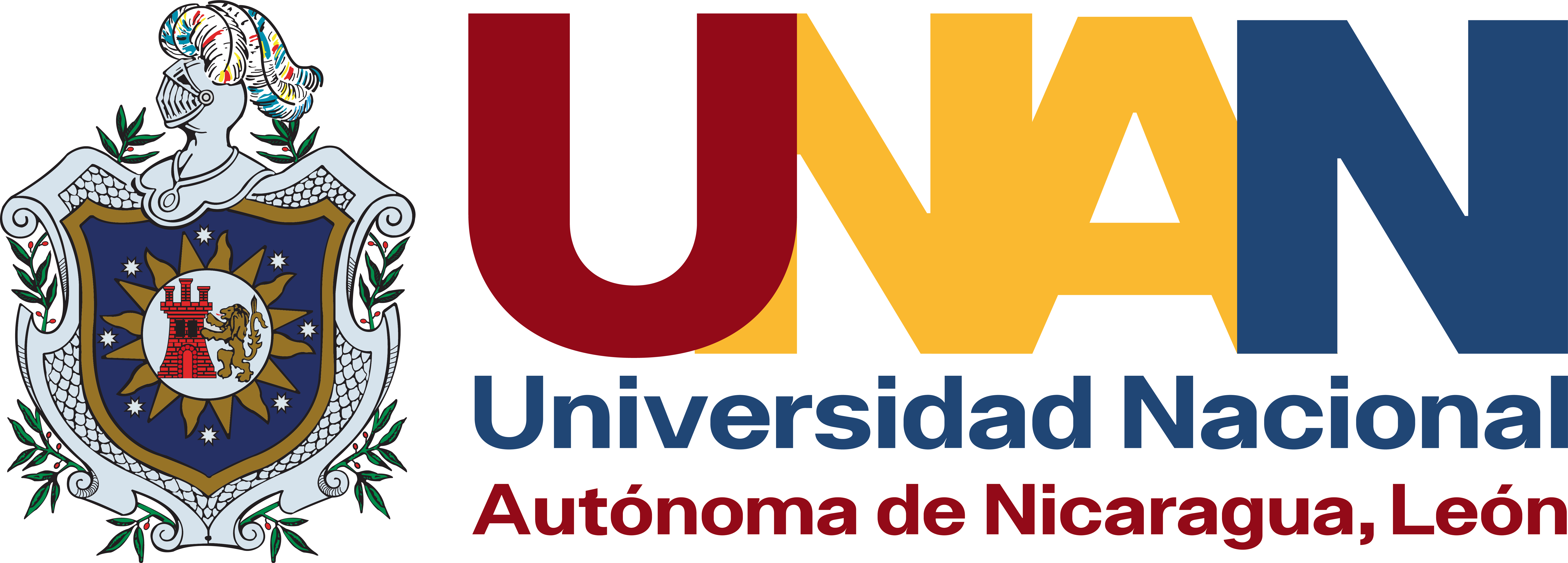Impact of biomass use on the bioeconomy of Central American sugar mills
DOI:
https://doi.org/10.5377/universitas.v5i1.1478Keywords:
Bioeconomy, Malmquist index, BiorrefineryAbstract
The purpose of this study was to measure the impact of the use of Biomass on the productive path of the Bioeconomy of the sugar Biorefineries in the Central American region, through the study of the total productivity of the factors. The data available in the FAO were used, which were organized in a data panel and the data envelopment analysis was applied with the Malmquist indices tool, the environmental technical efficiency approach was added, a model with three components was considered: productive, environmental and social. Likewise, the incidence of planetary solar geomagnetic activity on the productivity of biorefineries was investigated. The results were evaluated considering the solar activity and omitting it, the first show that only the countries Belize, El Salvador (11%), Nicaragua (4%) and Cuba (3%) show an average growth in productivity, unlike Costa Rica, Guatemala, Honduras and Panama presented a decrease in productivity. The change in TFP was explained by the technological development of the mills rather than by the technical efficiency of the workforce. In addition, it is concluded that the productivity of the bioeconomy has a certain relationship with the planetary geomagnetic activity and therefore the relationship between the productivity of biorefineries and the population growth rate must be taken into account. It is important that the investors of the sugar mills consider these evidences given that knowing the variations of the solar activity.
Downloads
References
Aguilar, N., Galindo, M., Guadalupe, F. y Javier, C. (2011). Factores de competitividad de la agroindustria de la caña de azúcar en México. Región y Sociedad. 23.
Azqueta, D. (2007). Introducción a la Economia ambiental 2a Edición. España. Mc Graw Hill. 493p.
Bravo-Uretra, B., Solis, D., Moreira. V., Maripani, J.. Thian, A.. y Rivas T.. (2007). Technical efficiency in farming: a Meta regression analysis, Journal of productivity Analysis. 27(1).57-72.
Bravo-Ureta, B., Moreira, V.. Arzubi, A., Schilder. E., Álvarez, J., Molina, C. (2008). Cambio tecnológico y eficiencia técnica en predios lecheros de tres países de Sudamérica. Chilean Journal of Agricultural Research, 68(4).360-367
Blanco, N y Zuniga, C. (2013). A New Case of Bio Economy in Nicaragua. Journal of Agricultural Studies, 1(1). Macrothink Institute. doi: 10.5296/jas.v111.3352. URL:http://dx.doi.org/10.5296/jas.vlil.3352
Coelli, T. (2008). A guide to DEAP versión 2.1: a data Envelopment Analysis computer program. CEPA Working Paper, 96.
Cabral da Costa, C., Lee Burnquist, H. y Martins, J. (2006). Relations of the regional Brazilian cane agro-industry with the national economy: analysis applied to the Centre-South and North-Northeast. Applied Economics. 38.519-531.
Comisión Económica para América Latina, CEPAL. (1985). Determinación de las necesidades de Energia y Proteinas de la población. Obtenido desde: http://www.eclac.cl/deype/mecovi/docs/TALLER4/10.pdf
Comisión Nacional de Productores de Azúcar, CNPA. (2012). Estoulisticas de producción de azúcar. Obtenido desde: http://www.cnpa.com.ni/indicadores
Consejo Nacional de Evaluación de la Política de Desarrollo Social, CONEVAL. (2012). Construcción de la Lineas de Bienestar. Documento Metodológico. México. D.F. Obtenido desde: http://www.coneval.gob.mx/Informes/Coordinacion/INFORMES_
Y_PUBLICACIONES_PDF/Construccion_lineas_bienestar.pdf
Dios-Palomares, R., Alcaide. D.. Diz, J., Bello, M., Guijarro, A y Züniga. C. (2014). La eficiencia ambiental mediante Analisis Envolvente de Datos Métodos y evidencias empiricas. En Zúmiga, C., Dios Palomares, R., Duran, O., Sol. A. En Estado del arte de la bioeconomia y el cambio climático/Red de Bioeconomia y Cambio Climático. (pp. 190-228). Leon, Nicaragua: Editorial Universitaria.
Dios-Palomares, R., Prieto, A., Martinez, J. (2008). Eficiencia Medioambiental y Forma Juridica en el Sector Oleicola. X7 Encuentro de Economia Aplicada, Salamanca, España.
European Commission, EC. (2005). New perspectives on the knowledge based bio-economy: A conference report. European Commission, Brussels, Belgium, 2005.
Figueroa. J. (2005). Valoración de la biodiversidad: Perspectiva de la economia ambiental y la economia ecológica. INCI 30 (2).103-107.
Farrel, M. (1957). The Measurement of productivity. Journal of the Royal Society, A CXX, 3,253-290.
González, A. y Kafarov, V. (2011), Microalgae based biorefinery: Issues to consider. A review, CT&F-Ciencia. Tecnologia y Futuro, 4(4),5-22.
Organización de las Naciones Unidas para la Agricultura y la Alimentación, FAO. (2003). Dieta, mutrición y prevención de enfermedades crónicas, Obtenido desde: ftp://ftp.fao.org/docrep/fuo/006/ac911s/ac911s00.pdf
Organización de las Naciones Unidas para la Agricultura y la Alimentación, FAO. (2007). Principios y aplicación de las muevas necesidades de energia según el Comité de Expertos FAO/OMS. Obtenido desde: http://www.cclac.org/publicaciones/xml/4/30044/LC12780e.pdf
Londoño. L... y Giraldo, Y. (2009). Análisis Envolvente de Datos-DEA-: Una aplicación al sector de telecomunicaciones de países de medianos ingresos Ecos de Economia, 28, 1-20.
Ludena C. (2012). Agricultural Productivity Growth, Efficiency Change and Technical Progress in Latin America and the Caribbean. Paper presentado para una presentación en la conferencia International de la asociación de economistas agricolas (International Association of Agricultural Economists Triennial Conference, IAAE), Foz do Iguaçu, Brasil.
Mohammadian, M. (2008). La bioeconomía: economía del tercer camino, entre la antigua economía y la nueva economía global. Revista de Estudios Empresariales, 2.118-121.
Menchu, E. y Osegueda. (2006). La canasta básica de los alimentos en Centroamérica. INCAP OPS, 60p.ISBN 99922-880-3-5. Obtenido desde: http://www.jaip.gob.hn/transparencia pdf Regulacion/exoneraciones/canasta%20basica/La%20Canasta%20Basica%20
de%20Alimentos%20en%20CA.pdf
Moreira J. (2006). Global biomass energy potential. Mitigation and Adaptation Strategies for Global Change, 11(2), 313-342,
Orduna, L. (2004), Análisis del concepto de la economia, la falacia de Robbins, Cuadernos de estudios empresariales, 14, 143-177,
O'Donnell C., (2012), Econometric estimation of distance functions and associated measures of productivity and efficiency change. Paper presentado para una presentación en la conferencia International de la asociación de economistas agricolas (International Association of Agricultural Economists Triennial Conference. IAAF). Foz do Iguaçu, Brasil.
Perlack, R., Wright, L., Turhollow, A., Graham, R., Stokes, B., y Erbach, B. (2005). Biomass as feedstock for a bioenergy and bioproducts industry: the technical feasibility of a billion-ton annual supply. Obtenido desde: http://web.ornl.gov/-webworks/cppry2001/rpt/123021.pdf
Pavone, V. (2012). Ciencia, neoliberalismo y bioeconomia. CTS: Revista iberoamericana de ciencia, tecnologia y sociedad, 7(20). 145-16.
Ramirez, R. (2008). Sostenibilidad y Eficiencia Energética en la Industria. CITCEA. Obtenido desde: http://es.scribd.com/doc/23525965/Eficiencia-Energetica-en-la-Industria
Sampieri R Fernández C; Baptista P. (2006). Metodologia de la investigación, 4a Edición, México. Mc Graw Hill. 850p.
Sánchez, J. (2007). Biotecnologia blanca e industria farmacéutica. An. R. Acad. Nac. Farm. 73.501-535.
Sierra. P y Baca, M. (2014). Actividad solar, clima y productividad agricola, posibles vinculos. En Zúniga, C. Dios Palomares, R.. Duran, O., Sol, A. Estado del arte de la bioeconomía y el cambio climático/Red de Bioeconomia y Cambio Climático. (pp. 122- 148), León, Nicaragua: Editorial Universitaria.
Trigo, E., Henry, G., Sanders, J., Schurr. U., Ingelbrecht, 1., Revel C., Santana, C., y Rocha, P. (2013). Towards bioeconomy development in Latin America and the Caribbean, Bioeconomy Working Paper. 1.
Trigo, E., Mentaberry, A., Cap. E., Zelada, A y Villarreal, F. (2011). El potencial de la bioeconomía y las bioretinerias en la Argentina. Obtenido desde: http://www.argentinainnovadora2020.mincyt.gob.ar/?wpfb dl 25
Trigo, E., Henry, G., Sanders, J., Schurr, U., Ingelbrecht, I., Revel C., Santana, C., y Rocha, P. (2013). Towards bioeconomy development in Latin America and the Caribbean. Bioeconomy Working Paper No.2013-01. ALCUE KBBE FP7 Project No. 264266, 15 р.
Torres-Degró, A. (2011). Tasas de crecimiento poblacional (r): Una mirada desde el modelo lineal, geométrico y exponencial. CIDE digital, 2(1),142-160.
Tripathi, K., Gupta, R., Verma, P., Y Khare, N. (2012). Association between Geomagnetic Kp and Ap Index with solar and interplanetary Parameters. Indian Journal of Scientific Research. 3(1), p153-156. Obtenido desde: http://web.a.ebscohost.com/ehost/pdfviewer/pdfviewer?vid=8&sid=6691c3c6-5090-4fb5-9196- 9a58da6c820f%40sessionmgr4005&hid=4106
U.S. Department of Energy, DOE. (2004). Year 2 biomass utilization, Final Technical Report. Obtenido desde: https://www.etde.org/etdeweb/servlets/purl/876436-McWqN1
Velásquez, K. 2012. Análisis de la actividad solar en los últimos 80 años. Tetrahedron, Elseviere.
Verbanac, G., Mandea, M., Vršnak, B., y Sentic, S. Solar Physics. (2011). Evolution of Solar and Geomagnetic Activity Indices and Their Relationship: 1960-2001. Solar Phys. 271(1/2). Pp183-195. DOI: 10.1007/s11207-011-9801-y. Obtenido desde: http://web.a.ebscohost.com/chost/pdfviewer/pdfviewer?vid=13&sid=6b91c3e6-5090-41 9a58da6c820f%40sessionmgr4005&hid 4106
Wangong. J., y Daniel, P. (2010). Análisis a la eficiencia de las fuentes de energia renovable. Revistas Ingenierias USBMed, 1(1).39-45.
Wagemann, K. (2010). Prerequisite for the Realization of a Future Bioeconomy. Reducing the Carbon Footprint of Fuels and
Petrochemicals DGMK Conference, Berlin, Germany. Obtenido desde: https://www.etde.org/etdeweb/servlets/purl/22072962/
Zuniga, C., Dios, R., Rangel, R., Aguilar, A., Blanco, N., Toruño, P., Salazar, W., Y caballero, A. (2014). Impacto del Cambio Climático en la producción agraria: Un caso de aplicación de instrumentos tradicionales de medición en la economia agricola. En Estado del Arte de la Bioeconomía y el Cambio Climático Red de Bioeconomia y Cambio Climático. (pp 173-188). León, Nicaragua: Editorial Universitaria.
Zúniga, C. (2010). Impacto de los Sistemas de Producción Agropecuarios en el Desarrollo Local Sostenible de Nicaragua, 1998-2005: Indice de Malmquist DEA con un producto Orientado. Universitas, 1(4). 10-17
Downloads
Published
How to Cite
Issue
Section
License
Copyright (c) 2014 National Autonomous University of Nicaragua, Leòn

This work is licensed under a Creative Commons Attribution-NonCommercial-ShareAlike 4.0 International License.
Copyright © 2025 Universitas (León), Revista Cientifíca de la UNAN-León. Academic Direction. Research Department. Publication and Scientific Event Unit.










